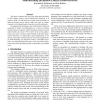Free Online Productivity Tools
i2Speak
i2Symbol
i2OCR
iTex2Img
iWeb2Print
iWeb2Shot
i2Type
iPdf2Split
iPdf2Merge
i2Bopomofo
i2Arabic
i2Style
i2Image
i2PDF
iLatex2Rtf
Sci2ools
ICDCS
1997
IEEE
1997
IEEE
Multi-threading and Remote Latency in Software DSMs
This paper evaluates the use of per-node multi-threading to hide remote memory and synchronization latencies in a software DSM. As with hardware systems, multi-threading in software systems can be used to reduce the costs of remote requests by switching threads when the current thread blocks. We added multi-threading to the CVM software DSM and evaluated its impact on performance for a suite of common shared memory programs. Multi-threading resulted in speed improvements of at least 17% in three of the seven applications in our suite, and lesser improvements in the other applications. However, we found that i) good performance is not always achievable transparently for non-trivial applications, ii) multi-threading can negatively interact with DSM operations, iii) multi-threading decreases cache and TLB locality, and iv) any multi-threading speedup is dependent on available work.
Distributed And Parallel Computing | ICDCS 1997 | Multi-threading | Multi-threading Decreases Cache | Software Dsm |
| Added | 06 Aug 2010 |
| Updated | 06 Aug 2010 |
| Type | Conference |
| Year | 1997 |
| Where | ICDCS |
| Authors | Kritchalach Thitikamol, Peter J. Keleher |
Comments (0)

